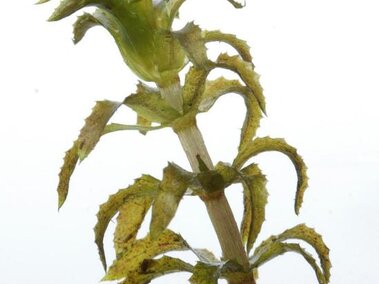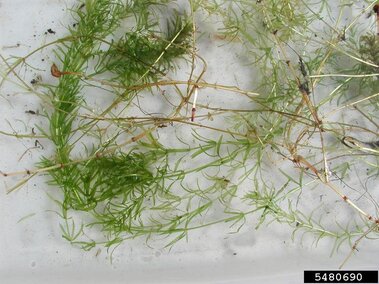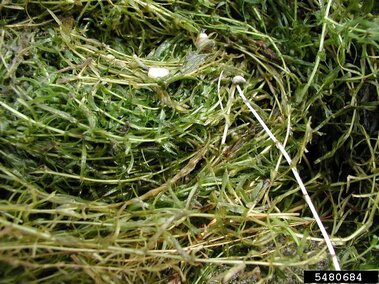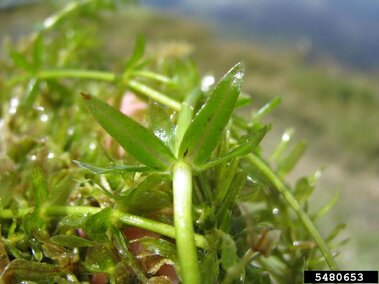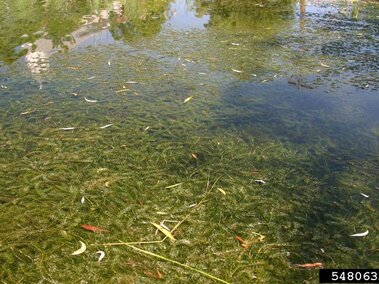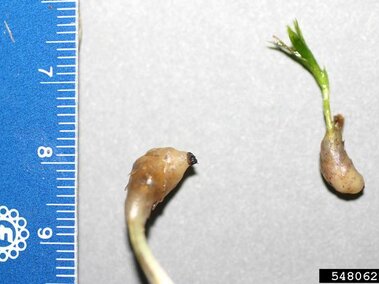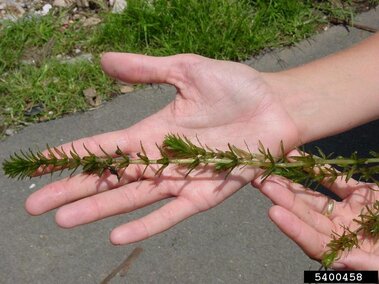General Information
Species Name: Hydrilla verticillata
Also Known As: Florida elodea, Indian star-vine, Royle waterthyme, water thyme
Family: Hydrocharitaceae (Frogbit)
Growth Form: Forb (submersed aquatic)
Life Span: Perennial
Flowering Dates: June-September
Origin: Asia
Noxious: Yes. Hydrilla is listed as a Federal Noxious Weed under the Plant Protection Act, which makes it illegal in the U.S. to import or transport the species between states without a permit.
Category 1: Potential Aquatic Invasive Species
Why Is It Invasive?
Hydrilla is considered one of the worst aquatic weeds in the United States; it can even outcompete other invasive plants like Eurasian watermilfoil. It forms dense mats at the surface of the water. The dense mats can restrict native vegetation, irrigation practices, recreation, hydroelectric production, and water flow. It can invade most slow-moving or still water systems. These mats crowd out native vegetation and reduce habitat for fish and other wildlife. The plant quickly spreads into new areas within a waterbody once introduced.
What Does It Look Like?
General Characteristics
Hydrilla is a submersed, rooted aquatic plant that can grow in water up to depths of 20 ft. (6.1 m). Plants can survive in depths up to 40 ft. (12 m) in non-turbid water.
Flowers
Hydrilla have both male and female flowers that may be growing on the same or different plants. Flowers have 3 petals that float towards the surface, either translucent with white sepals (female) or white to red with red or brown sepals (male). Only the female flowers of this dioecious plant have been found in the United States, which means no viable seed are produced.
Leaves
Leaves are whorled in bunches of 3-8, but most often with whorls of 5. The midribs of the leaves are reddish in color with the undersides having small, raised teeth. Leaves are 0.2-0.8 in. (5-20 mm) long, less than 0.1 in. (2 mm) wide and have serrated margins.
Stems
It has long stems that branch at the surface where growth becomes horizontal and dense mats form. Plant stems root in the soil and grow up towards the surface water. Stem lengths of up to 30’ have been reported in Florida.
Seeds
Turions (stem tubers) are bud-like structures which can drop off the plant and successfully survive freezing or drought. Tubers from the rhizomes are another way these plants reproduce and increase their invasive potential.
Photos
Where Does It Grow?
Hydrilla grows in freshwater areas of lakes, rivers, ponds, streams, wet ditches, and other moving water. The plants are rooted to the bottom and can form dense areas of under-water and topped-out vegetation.
How Does It Spread?
This plant was first introduced into the United States as an aquarium plant. Hydrilla is mainly introduced to new waters as castaway fragments on recreational boats, their motors and trailers, and in live wells. Stem pieces root in the substrate and develop into new colonies, commonly beginning near boat ramps. Once established, boat traffic continues to shatter and spread hydrilla throughout the waterbody. Both types propagate primarily by stem fragmentation, although axillary buds (turions) and subterranean tubers are also important. Tubers are resistant to most control techniques and may be viable as a source of reinfestation for years.
How Do I Control It?
Management of invasive aquatic plants involving either mechanical removal of plants or application of herbicides to public waters requires a permit. Contact the Contact the Nebraska Game and Parks Commission for more information.
Mechanical
Cutting or pulling the plant by hand or with equipment such as rakes or cutting blades could break it into fragments, allowing it to further spread. Contact the Nebraska Game and Parks Commission to determine appropriate removal methods.
Cultural
CLEAN your watercraft, trailer, angling gear and other equipment. Remove all aquatic vegetation and animal species from your equipment.
DRAIN your watercraft at the ramp by removing the boat plug and draining all live wells and ballast tanks.
DRY your watercraft, trailer and other equipment for at least 7 days before visiting another waterbody.
DON'T LET IT LOOSE. Do not release or transport exotic or non-native fish species to new ecosystems, and do not dump aquariums. It is unlawful to release any aquatic species into a waterbody other than the one from which it was harvested. Doing so can promote the spread of AIS.
Chemical
Application of chemicals to public waters requires a permit. Contact the Contact the Nebraska Game and Parks Commission for more information.
What Should I Do If I See It in Nebraska?
If you see hydrilla in Nebraska, you should report it to the Nebraska Game and Parks Commission's Aquatic Invasive Species (AIS) Program using their AIS Report Form. For guidance on what information to include in your report, check out our reporting tips.
References and More Information
Center for Invasive Species and Ecosystem Health
King County, Washington Noxious Weeds
Stubbendieck, J., Coffin, M., & Dunn, C. (2019). Weeds of the Great Plains. Nebraska Department of Agriculture
USDA National Invasive Species Information Center
Nebraska Game and Parks Commission


